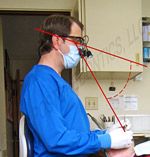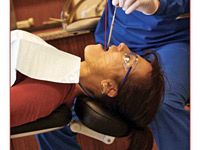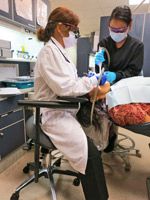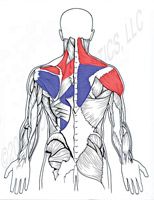4 evidence-based ergonomic strategies to save your dental career
Did you know that nearly two thirds of dentists who retire early are forced to due to a musculoskeletal disorder? And that studies show the prevalence of work-related pain in dentistry today is roughly the same as it was in 1946?
Did you know that nearly two thirds of dentists who retire early are forced to due to a musculoskeletal disorder? And that studies show the prevalence of work-related pain in dentistry today is roughly the same as it was in 1946?
Every dentist knows that accurately identifying the etiology of their patient’s pain and implementing the latest evidence-based treatment is the most effective way to treat patients. Likewise, it is only when dental ergonomic interventions are both evidence-based and targeted at the etiology of the problem that we find effective solutions that reduce pain and extend careers.
Ergonomic and wellness strategies are imperative to a long and healthy career in dentistry. If you implement the correct ergonomic principles in your practice, you should not have to constantly think about “sitting up straight.” You have plenty of other things to think about chairside! The positioning of your stool, loupes and patient, plus implementation of the correct exercises, should cause you to sit up straight without thinking about it.
So let’s get started with the top four career-saving ergonomic interventions.
Free on-demand webinar: Understanding medical billing and its relationship with 3D
Keep it steep.

Studies show that forward head posture greater than 20 degrees is one of the greatest contributing factors to neck pain. A forward head posture less than 20 degrees requires dental loupes with a very steep declination angle. In my experience, only one style of loupe consistently keeps all operators within the safe head posture. This style is a vertically adjustable flip-up loupe, which provides a declination angle of up to 55 degrees. When properly adjusted, this loupe easily keeps the dental professional in a head posture of less than 20 degrees forward. Weight is no longer an issue with flip-ups as there are ultra lightweight flip-up loupes on the market today that rival the weight of through-the-lens loupes.
So why is vertical adjustability important in a flip-up loupe? Imagine if your scope won’t adjust lower than the level of your pupil-you will have to lean forward just to see through it! The scopes must sit significantly lower than your pupil in order to optimize the steep declination angle that a flip-up loupe offers. Four flip-up loupes with vertical adjustability on the market that meet these ergonomic criteria are reviewed at posturedontics.com.
Related reading: 5 ergonomic products you should know
Continue reading on Page 2 ...
Control the plane.

One of the primary reasons I see students and clinicians leaning forward is due to poor control of the occlusal plane when treating the upper arch. When the occlusal plane of the upper arch is in front of the vertical, it pulls the dentist into a forward-leaning posture.
To maintain optimal posture, the occlusal plane of the upper arch must be 20-25 degrees behind the vertical. This is most easily achieved with a double articulating headrest. However, most dentists and hygienists do not angle the double articulating headrest steeply downward for risk of causing patient discomfort. Many of these headrests are not sufficiently cushioned on the edge and can cut into the patient’s occiput.
The secret to getting the patient to tolerate positioning the occlusal plane behind the vertical is comfort. Once the patient is comfortable, he or she will tolerate a surprising amount of reclining without objection! A new low-profile headrest cushion by Crescent Products is ideal for use with double articulating headrests. Many are familiar with the original Crescent headrest cushion (which is ideal for use with a flat headrest), but it is too large to use on most double articulating headrests, especially when treating the upper arch.
The List: The top 4 unconventional ergonomic tips
Saddle up!

For those unfamiliar with saddle stools, they may seem unconventional compared to traditional flat operator stools. However, with the prevalence of back pain in dentistry unwavering (around 65 percent), alternative methods for sitting are gaining increased recognition. Because the saddle stool has resolved multiple ergonomic problems in one single intervention in my consultations, I recommend every dentist and hygienist try a saddle stool at some point their career.
The benefits of saddle stools in dentistry are numerous and include:
• The stool places you in a “tripod” position, which is the most stable position for the hip joint.
• Diaphragmatic breathing is improved.
• Easier to get close to and move around the patient.
• Minimizes the need for backrest support.
• Neutral spinal posture promotes correct head posture and proper shoulder movement.
• Enables easier access in the 12 o’clock position.
• Easier to move correctly from the sit-to-stand position.
The saddle stool places your pelvis in a neutral position, allowing the spinal curves to easily balance on it. Use of the saddle stool has completely resolved lower back pain in a number of operators with whom I have consulted. Remember that a saddle stool should never be tilted forward unless the user has congenital hypolordosis.Tilting the seat of a saddle stool forward can create lower back pain. The proper height adjustment of the saddle stool will place the thighs at a 45-degree downward angle.
Related reading: Maximizing the life of your practice with ergonomics
Continue reading on Page 3 ...
Exercise caution.

In a society that bombards us with exercise options, it’s hard to imagine strengthening your muscles could be anything but beneficial. Yet, because of their predisposition to unique muscle imbalances, all exercise is not necessarily good exercise for dental professionals. In fact, generic exercise routines that are not a problem for the general population can throw some dental professionals into the vicious pain cycle. To correct this muscle imbalance, dental professionals should focus on strengthening the core stabilizing muscles of the shoulder girdle, rotator cuff and trunk. An example of the muscle imbalances of the posterior body in dental professionals is shown to the left. Dental professionals should focus on muscular endurance training of the key stabilizing muscles (in blue) and avoid over-strengthening muscles that are already prone to imbalance, tightness, ischemia and pain (in red).
How dental professionals train these stabilizing muscles is the secret to success. Muscle endurance is the ability of a muscle to repeat a task or hold a contraction over a prolonged period of time without fatiguing. Muscular endurance is exactly what dental professionals demand of their muscles chairside-hence, it is exactly how they should train their muscles. Exercise programs to improve muscle endurance are characterized by low resistance, high repetitions and little recovery between sets. The target of endurance training is the deep, postural-stabilizing muscles of the spine, shoulder girdle and rotator cuff. When properly trained, these muscles allow you to work with optimal posture for longer periods of time without discomfort.
Specific exercise to correct muscle imbalances is especially important for women in dentistry, who are generally about 50 percent weaker than men in upper-body strength and 30 percent weaker in the lower body. Female dentists who have less endurance of the shoulder muscles tend to have more neck and shoulder pain.
Related reading: The biggest ergonomic mistakes dental professionals make
Specific exercises that can worsen these muscle imbalances are vertical rows, overhead (military) press, bench press, shoulder abduction and supine exercises that require lifting the head off the floor, among many other exercises and gym machines.
Remember, as you work your way to wellness, the problem of work-related pain didn’t happen overnight and, therefore, is often not a quick fix. Keep in mind that therapies aimed at immediate results are usually temporary. Be patient and resolve ergonomic issues in your operatory! I have seen dentists spend a good sum of money on personal trainers, chiropractors, mattresses and tilt tables only to return each day to the operatory scenario that likely caused the problem in the first place.
Work-related pain and injury is not a necessary consequence of your occupation. With the correct evidence-based interventions, you can put yourself on the path toward a long and healthy career. We will explore many more ergonomic and wellness strategies in future DPR columns, because, after all, what good is your lucrative dental career if your body retires before you do?
About the author
DPR Ergonomics Editor Bethany Valachi, PT, MS, CEAS, is author of the book, “Practice Dentistry Pain-Free: Evidence-based Strategies to Prevent Pain and Extend your Career” and clinical instructor of ergonomics at OHSU School of Dentistry in Portland, Ore. A physical therapist who has worked exclusively with dental professionals for more than 15 years, she is recognized internationally as an expert in dental ergonomics and has been invited to lecture at more than 300 conferences worldwide, including the International Dental Ergonomics Congress in Krakow, Poland, and the Asia Pacific World Dental Conference in Dubai. She has published more than 50 articles in peer-reviewed dental journals and has developed patient positioning and exercise DVDs specifically for dental professionals. She offers free newsletters, articles, videos and product reviews on her website at posturedontics.com. Valachi can be reached at info@posturedontics.com.
ACTIVA BioACTIVE Bulk Flow Marks Pulpdent’s First Major Product Release in 4 Years
December 12th 2024Next-generation bulk-fill dental restorative raises the standard of care for bulk-fill procedures by providing natural remineralization support, while also overcoming current bulk-fill limitations.